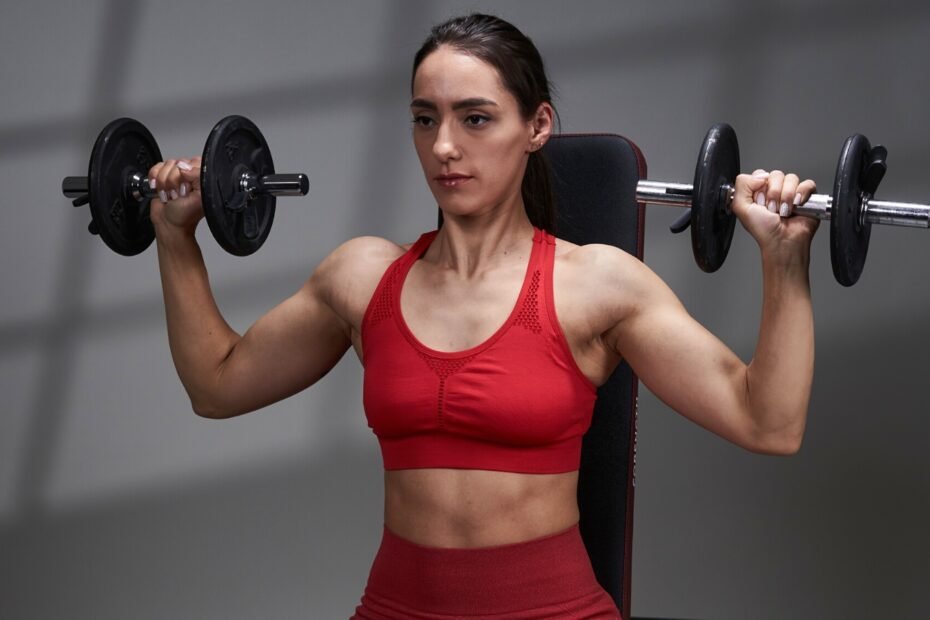The dumbbell shoulder press is a foundational upper body exercise that prominently targets the front deltoid, among other muscles, delivering an array of benefits for shoulder strength, aesthetics, and overall fitness. This comprehensive guide covers the proper technique, advantages, alternative exercises, and variations to diversify your shoulder training regimen.
Muscle Worked:
The dumbbell shoulder press primarily targets the following muscles:
- Primary Muscle: Front Deltoid (Anterior Deltoid)
- Secondary Muscles: Triceps, Upper Trapezius, Serratus Anterior
How to Do The Dumbbell Shoulder Press:
Executing the dumbbell shoulder press with precision ensures optimal results and minimizes the risk of injury. Follow these step-by-step instructions:

- Setup: Sit on a bench with back support or stand with your feet shoulder-width apart. Grasp a dumbbell in each hand at shoulder height, palms facing forward.
- Starting Position: Engage your core, maintain an upright posture, and ensure your elbows form a 90-degree angle resembling a goalpost.
- Pressing: Exhale as you extend your arms, lifting the dumbbells upward. Maintain neutral wrist alignment throughout the movement.
- Peak Contraction: When the dumbbells reach the overhead position, they should align with your shoulders, leaving a slight gap between them.
- Lowering: Inhale slowly as you lower the dumbbells, avoiding any bouncing or reliance on momentum.
- Repeat: Perform the desired number of repetitions while upholding proper form and controlled movement.
Benefits:
Discover the wide-ranging benefits that the dumbbell shoulder press brings to your fitness routine:
- Front Deltoid Development: The exercise primarily targets the front deltoid, resulting in well-defined and sculpted shoulders.
- Upper Body Power: Engaging the triceps and upper trapezius contributes to overall upper body strength enhancement.
- Functional Strength: By replicating the motion of pushing objects overhead, this exercise enhances functional strength.
- Joint Stability: Stabilizer muscles are activated, leading to improved shoulder joint stability and reduced injury risk.
- Balance and Symmetry: Consistent practice can contribute to a balanced and symmetric upper body appearance.
- Expanded Range of Motion: The use of dumbbells allows for a greater range of motion compared to barbell presses.
Alternative Exercises:
Elevate your shoulder training by incorporating these alternative exercises, each offering unique benefits:
- Seated Dumbbell Shoulder Press: The seated position isolates the shoulders for focused engagement.
- Arnold Press: Introducing rotation adds a novel dimension to deltoid activation.
- Single-Arm Dumbbell Press: This variation challenges stability and balance while targeting each shoulder individually.
- Push Press: By incorporating leg drive, you can lift heavier weights.
- Landmine Shoulder Press: This versatile movement targets the shoulders from a different angle.
- Pike Push-Ups: Utilizing your body weight mimics the shoulder press motion.
- Resistance Band Shoulder Press: Resistance bands intensify the exercise for added challenge.
Variations:
Infuse variety into your routine with these effective variations:
- Neutral Grip Dumbbell Shoulder Press: Palms facing each other reduces stress on the shoulder joints.
- Incline Dumbbell Shoulder Press: Perform on an incline bench to stimulate the muscles from a different angle.
- Decline Dumbbell Shoulder Press: A decline bench changes the challenge for your muscles.
- Z Press: Seated on the floor, this variation increases core engagement.
- Half-Kneeling Dumbbell Shoulder Press: Enhances core activation and stability demands.
- Dumbbell Push Press: Incorporate a slight leg dip for explosive lifting power.
Incorporating the dumbbell shoulder press and its variations can lead to well-developed front deltoids, improved upper body strength, and enhanced functional fitness. Always prioritize proper form, progressively increase weights, and tailor your routine to your fitness level and goals. If you have any existing shoulder concerns or injuries, consulting fitness professionals or healthcare providers is advisable before engaging in these exercises.
